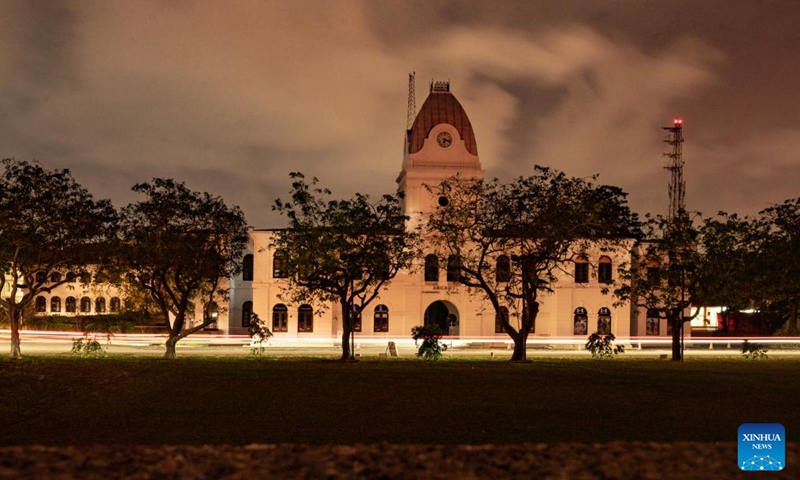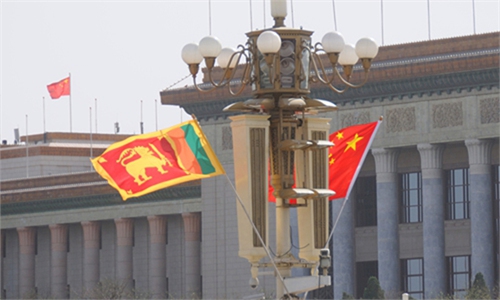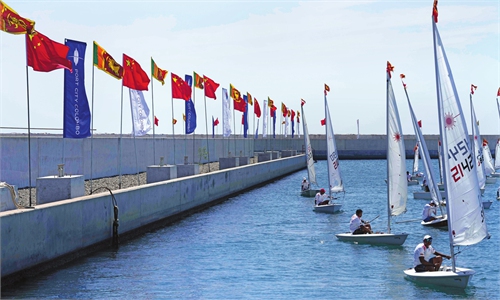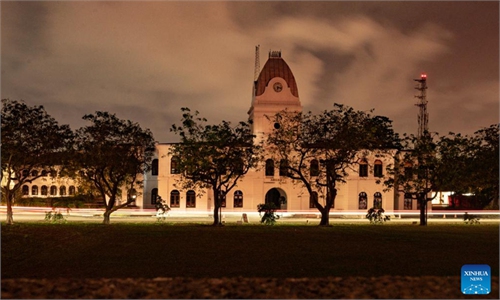
Photo taken on April 1, 2022 shows the exterior view of a shopping center during the power cut in Colombo, Sri Lanka. Sri Lanka declared an islandwide curfew from 6 pm Saturday to 6 a.m. Monday as the country faced a severe power crisis and rising inflation.Photo:Xinhua
Sri Lanka has been plunged into the worst economic crisis since its independence in 1948, after President Gotapaya Rajapaksa announced an economic emergency in September 2021. According to the country's central bank, there is only $2 billion foreign exchange reserves and $1 billion worth of notes maturing in July 2022. The country's debt-to-GDP has increased from 85 percent in 2019 to 104 percent in 2021. The current foreign exchange shortage has led to great difficulties in obtaining the supply of daily necessities, including fuel, electricity, papers, milk powder, etc. The country is facing hours of power cuts each day and even the newsprint has halted as a result of the shortage of printing paper. The general inflation rate in the country is more than 17 percent and the food inflation rate reaches 30.2 percent in March.Sri Lankan mainstream media outlets said it was some of the inefficient governance measures that led to the current crisis. However, some Western media are circulating the untrue claim that it is China's "debt trap" that led Sri Lanka to fall into the economic crisis. The statistics of the Sri Lankan government reveal the debt structure of the country is complex. Colombo borrowed the most from the global capital market, which constitutes 47 percent of its total debt, then comes the Asian Development Bank (ADB) with 13 percent, Japan 10 percent, China 10 percent, the World Bank 9 percent and India 2 percent. It proves the so-called 'debt trap' does not jibe with the facts and is fabricated to mislead Sri Lankans and even the international community.
There is a saying that no root, no fruit. The country's economic crisis has been years in the making. The direct cause is the COVID-19 pandemic. After the global outbreak of the epidemic, Sri Lanka's tourism sector, a cornerstone of the economy, was devastated. The tourism industry lost more than $4 billion each year since 2020, accounting for 10 percent of the country's GDP. At the same time, remittance from Sri Lankan workers overseas, which accounts for 26 percent of the country's foreign exchange, experienced a sharp decrease of 22.7 percent in 2021. These two factors greatly contributed to the fluidity of the country's foreign exchange reserve.
On the other hand, some of the country's measures led to domino effects in the economy. Sri Lanka banned the use of chemical fertilizers in farming in 2021 and announced to be the first country in the world to build a 100 percent organic agriculture sector. The push towards a pure organic farming in Sri Lanka cut the production of crops by half and further aggravated the situation. Speculators hoarded essential supplies, pushing up the prices in market.
Meanwhile, Sri Lanka's domestic economy has not been transformed and upgraded since the recovery from the civil war. The country did not find its position in the global industrial supply chain. After the civil war ended in 2009, the country has promoted economic and social development through vigorous construction of infrastructure and improvement of business environment. The economic growth rate has quickly rebounded. According to the World Bank, Sri Lanka's GDP growth rate reached 8 percent in 2010, 8.4 percent in 2011 and 9.1 percent in 2012.
Unfortunately, the government has not seized the change to restructure Sri Lanka's economy and put forward large-scale reforms. Growth has been driven by construction and domestic retail, neither of which can be traded on the global market. Sri Lanka's exports remain concentrated in textiles and agricultural products such as tea and rubber, which remain the country's main source of foreign exchange. With the rapid improvement of manufacturing in the rest of the world, Sri Lanka's textile exports are also losing its competitiveness.
In addition, the main means of production and daily necessities are highly dependent on imports and that makes the overall economic resilience weak. Economic growth is lagging since 2013. The GDP growth rate dropped to 3.4 percent in 2013, and only 2.3 percent in 2019. Sri Lanka's GDP growth rebounded to 8 percent in the first half of 2021, as its economy contracted 3.6 percent in 2020. The fiscal deficit and domestic inflation have actually worsened.
Facing such a difficult situation, there are no quick fixes for Sri Lanka. The urgent task is to ensure domestic stability. Without social stability, there can never be development.
In the long term, it is important for Sri Lanka to make suitable strategic choices. A time-tested and trustworthy partner like China favors Sri Lanka's interests. China and Sri Lanka enjoy deep traditional friendship and a solid foundation for cooperation. Back in the early days of the founding of the PRC, China was in urgent need of importing a variety of materials, including rubber. At the time, the price of rubber, the mainstay of Sri Lanka's exports, had plummeted, while the import of rice had tripled. Against this background, China and Sri Lanka signed the Rubber-Rice Pact in 1952, which has played an important role in promoting social and economic recovery and development of the two countries.
The spirit of "independence, self-improvement, unity and mutual assistance" embodied in the Rubber-Rice Pact, which is still adaptable for today's development trend. Moreover, the economic and trade cooperation between China and Sri Lanka has reached a new level under the Belt and Road Initiative, and China has become the largest trading partner of Sri Lanka.
Since the outbreak of COVID-19, the two countries stand with each other in all aspects, including vaccines and medical equipments. China has agreed to a 10 billion yuan swap agreement with Sri Lanka in December to help alleviate Sri Lanka's economic emergency. All these facts are true reflections of the "sincere mutual assistance and everlasting friendship" strategic cooperative partnership between the two countries.
Moreover, the Sri Lankan government needs to adjust the country's economic structure. Once the situation gets better, more and more focus should be put on the digital economy. According to the World Bank, Sri Lanka's telecom sector is already producing 32 percent more than before the pandemic, its information-technology sector has expanded by 20 percent, and the financial services sector by 28 percent. From this perspective, Sri Lanka has a promising future in developing digital technology and services.
Meanwhile, the supply chain dynamics can get improved with the help of China. Greater investments should be made in education and social protection to develop the domestic labor market. Many countries have emerged stronger from a crisis, and Sri Lanka should not be an exception.
The author is a research fellow at Centre for BRICS Studies at the Communication University of China and a distinguished fellow at South Asian Studies Center at Xiangtan University. bizopinion@globaltimes.com.cn



